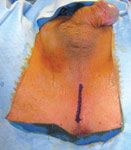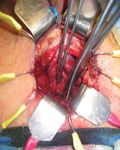Article
Using urethral slings to manage post-radical prostatectomy incontinence
Despite advances in surgical technique and the recent advent of laparoscopy and robotic assistance, urinary incontinence remains a real and potential problem for patients after radical prostatectomy.

Overall, roughly 8% of all open radical prostatectomy patients are permanently incontinent (JAMA 2000; 283:354-60). The older the patient, the more likely he is to become incontinent following surgery and to never regain urine control. After prostate surgery, urine control for most men improves with time, with the most significant improvement occurring in the first 3 months. Seventy-one percent of patients leak less than one pad per day by 3 months, and 87% of men leak less than one pad per day by 6 months (J Urol 2004; 171:1216-9).
In other words, significant and gradual return of urine control levels off after 6 months post-surgery. Therefore, we typically do not consider any stress incontinence surgery until 6 months post-prostatectomy.
Bone-anchored male sling
A bone-anchored male urethral sling (InVance Male Sling, American Medical Systems, Minnetonka, MN) is a fixed, compressive device introduced in 2000. The urethral sling is placed via a perineal incision, and consists of a 4- × 7-cm piece of silicone-coated mesh (Intemesh, American Medical Systems) that is anchored to the superior pubic rami with six bone screws threaded with polypropylene suture, using a disposable, battery-operated inserter/drill (InVance Inserter). The typical candidate for this sling has stress incontinence requiring one to four pads per day, where the external sphincter is scarred or fixed open.
Each screw has two pre-attached No. 1 polypropylene sutures that will be threaded through the mesh. Three screws are each placed 2 cm apart on each side of the ramus (six total).
In order to securely place the screws, the periosteum must be properly exposed. The crus of the penis typically overlies the pubic ramus, and often must be dissected off the bone and displaced laterally so as not to put the bone anchor through the crus. We typically use a combination of sharp scissor dissection and blunt dissection with a Kittner dissector. Once we have exposed the periosteum at three points on each side, we puncture the periosteum with an 18-gauge needle and confirm that we are on bone.






